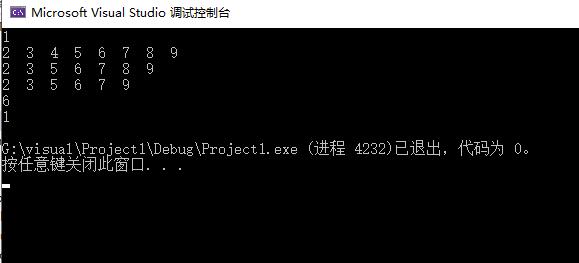1 #include<iostream> 2 #define Max 50 3 4 #define OK 1 5 using namespace std; 6 //顺序链表c语言版(a1,a2...an) 7 typedef int ElemType; 8 typedef struct //s顺序链表定义 9 { 10 ElemType* elem; 11 int length; 12 }ListLink; 13 14 int ListInit(ListLink&List)//顺序链表初始化 15 { 16 List.elem = (ElemType*)malloc(sizeof(ElemType) * Max); 17 if (!List.elem)//内存分配上失败退出程序 18 exit(-1); 19 List.length = 0; 20 return OK; 21 } 22 23 ElemType ListGet(ListLink& List, int i)//得到顺序链表第i个位置元素 24 { 25 if (i<1 || i>List.length) 26 return false; 27 return List.elem[i - 1]; 28 } 29 30 bool ListInsert(ListLink& List, int i, ElemType data)//顺序链表在第i个位置插入元素data 31 { 32 if (i<1 || i>List.length) 33 return false; 34 if (List.length >= Max) 35 return false; 36 for (int j = List.length ; j >= i; --j) 37 List.elem[j] = List.elem[j-1]; 38 List.elem[i- 1] = data; 39 ++List.length; 40 return true; 41 } 42 43 bool ListInsertHead(ListLink& List, ElemType data)//在头部插入一个元素 44 { 45 if (List.length >= Max) 46 return false; 47 for (int j = List.length-1; j >=0; --j) 48 List.elem[j + 1] = List.elem[j]; 49 List.elem[0] = data; 50 ++List.length; 51 return true; 52 } 53 54 bool ListInsertEnd(ListLink& List, ElemType data)//在尾部插入一个元素 55 { 56 if (List.length >= Max) 57 return false; 58 List.elem[List.length] = data; 59 ++List.length; 60 return true; 61 } 62 63 bool ListDeleteIndex(ListLink& List, int i)//按位置删除元素 64 { 65 if (i<1 || i>List.length) 66 return false; 67 for (int j = i; j < List.length; ++j) 68 List.elem[j - 1] = List.elem[j]; 69 --List.length; 70 return true; 71 } 72 73 bool ListDeleteElem(ListLink& List, ElemType data)//按值删除元素 74 { 75 for (int j = 0; j < List.length; ++j) 76 { 77 if (List.elem[j] == data) 78 { 79 for (int t = j; t < List.length-1; ++t) 80 List.elem[t] = List.elem[t+1]; 81 --List.length; 82 return true; 83 } 84 } 85 return false; 86 } 87 88 void ListClear(ListLink& List)//删除顺序链表全部元素 89 { 90 if (List.length) 91 { 92 for (int i = List.length-1; i >=0 ; --i) 93 { 94 List.elem[i-1] = List.elem[i]; 95 List.length--; 96 } 97 } 98 } 99 100 int ListLength(ListLink& List)//获取顺序链表长度 101 { 102 return List.length; 103 } 104 105 bool ListFull(ListLink& List)//顺序链表是否为满 106 { 107 return List.length == Max; 108 109 } 110 111 bool ListEmpty(ListLink& List)//顺序链表是否为空 112 { 113 return List.length == 0; 114 115 } 116 117 void ListShow(ListLink& List) 118 { 119 for (int i = 0; i < List.length; ++i) 120 cout << List.elem[i] << " "; 121 } 122 123 int main() { 124 ListLink lis; 125 ListInit(lis); 126 cout << ListEmpty(lis) << endl; 127 ListInsertHead(lis, 4); 128 ListInsertHead(lis, 3); 129 ListInsertHead(lis, 2); 130 ListInsertEnd(lis, 7); 131 ListInsertEnd(lis, 8); 132 ListInsertEnd(lis, 9); 133 ListInsert(lis, 4, 5); 134 ListInsert(lis, 5, 6); 135 ListShow(lis); 136 cout << endl; 137 ListDeleteIndex(lis, 3); 138 ListShow(lis); 139 cout << endl; 140 ListDeleteElem(lis, 8); 141 ListShow(lis); 142 cout << endl; 143 cout << ListLength(lis) << endl; 144 ListClear(lis); 145 cout << ListEmpty(lis) << endl; 146 return 0; 147 148 }
